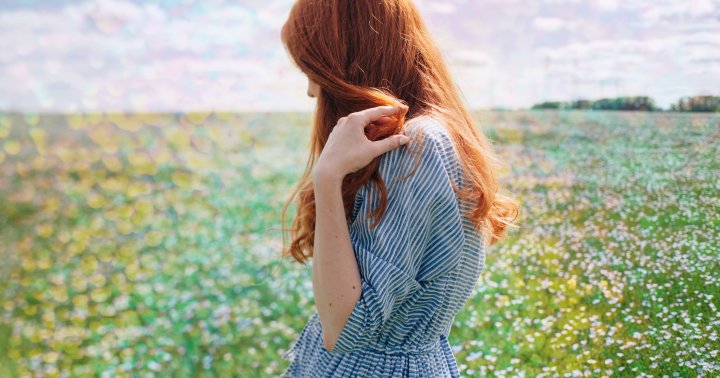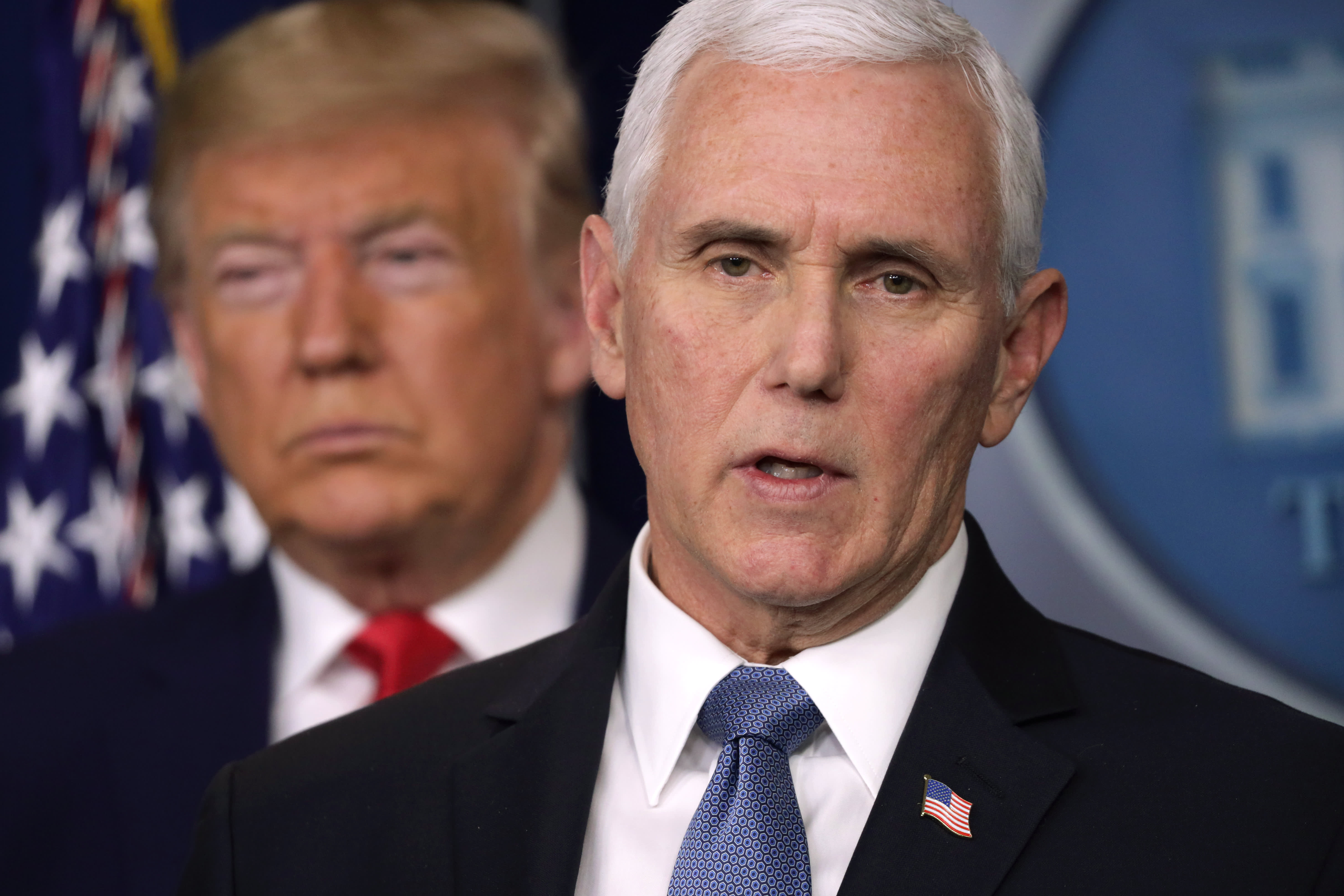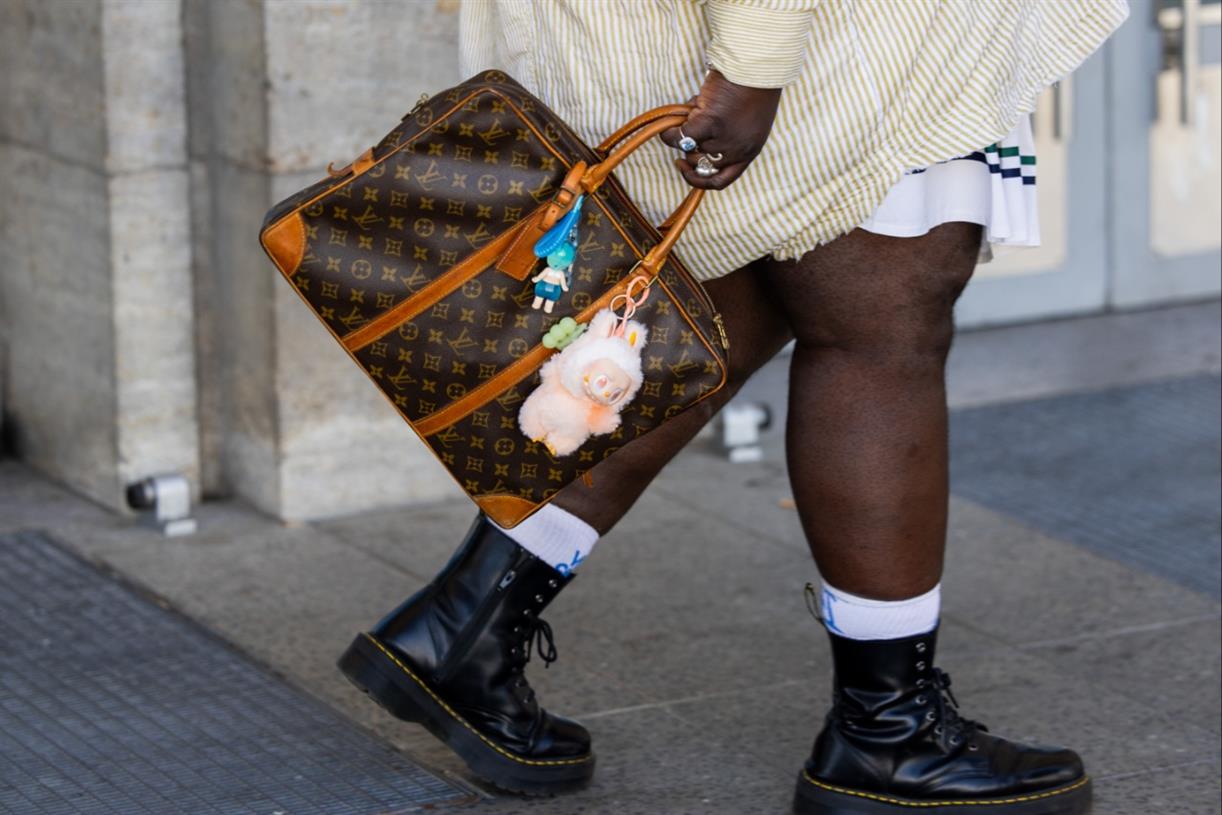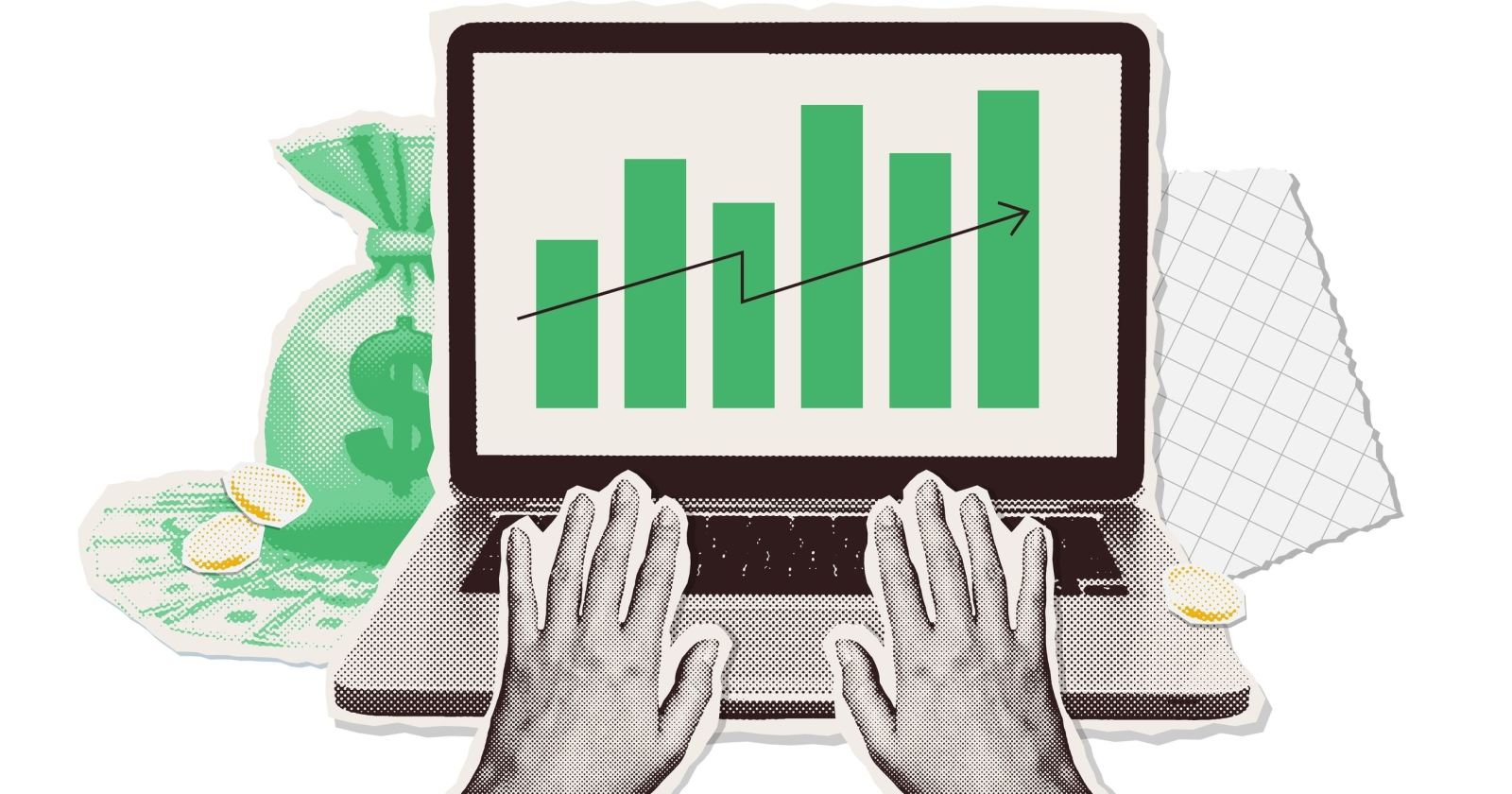Kukkuripa’s Dog and the Sacred Animals in Buddhism — Power Animals of Enlightened Deities and their meaning
In Buddhism generally, there are many different animals that are seen as sacred and have immense power. Even in early Pali Suta, animals such as snakes, elephants and horses are prominent. The Jataka tales, stories of Shakyamuni Budddha’s earlier...
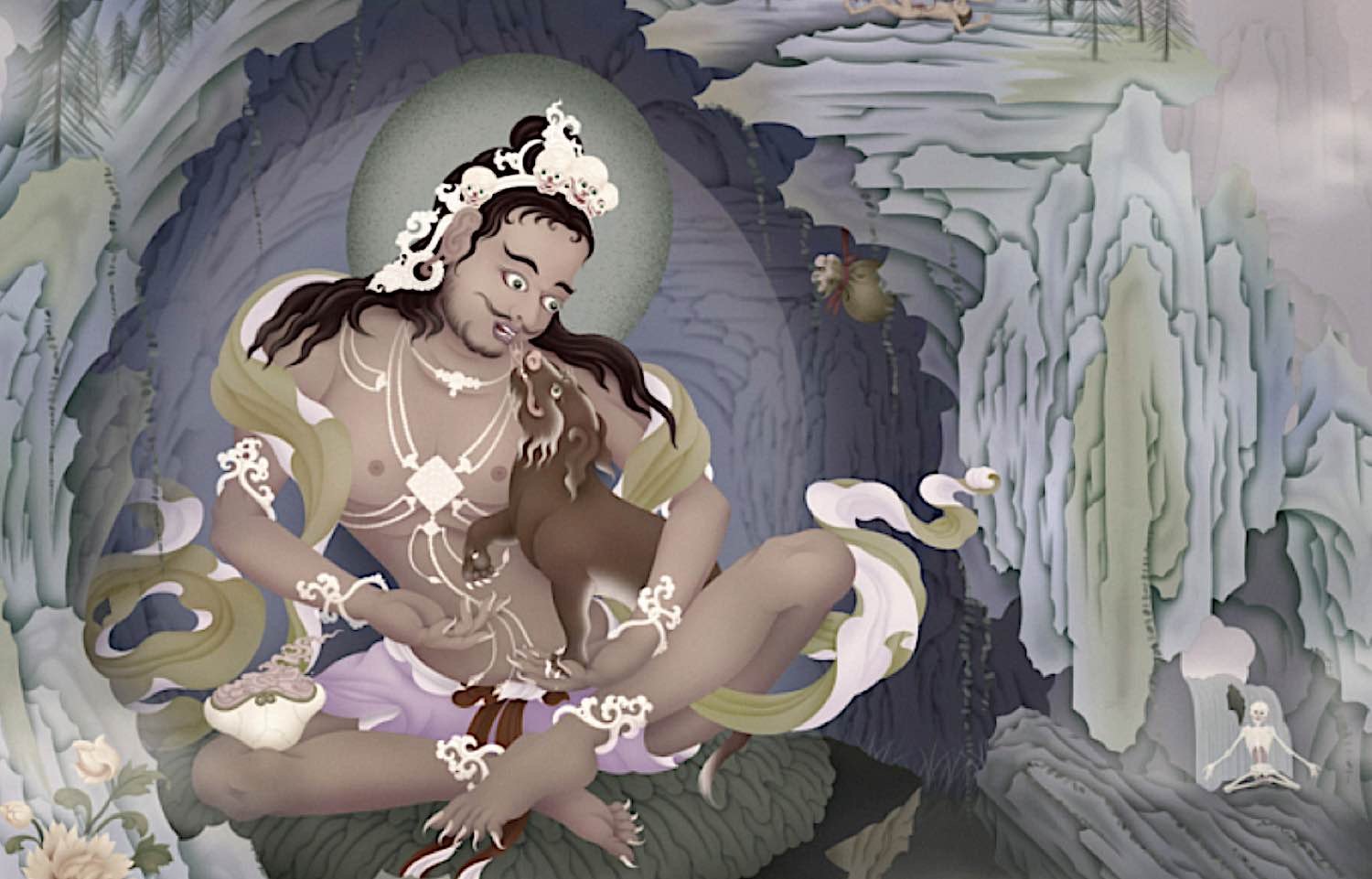
In Buddhism generally, there are many different animals that are seen as sacred and have immense power. Even in early Pali Suta, animals such as snakes, elephants and horses are prominent. The Jataka tales, stories of Shakyamuni Budddha’s earlier lives, feature many animals from mice to rabbits to horses to tigers. Not to be missed in the story Kukkuripa Mahasiddha (full story and image below!) who found Enlightenment with the help of his dog.
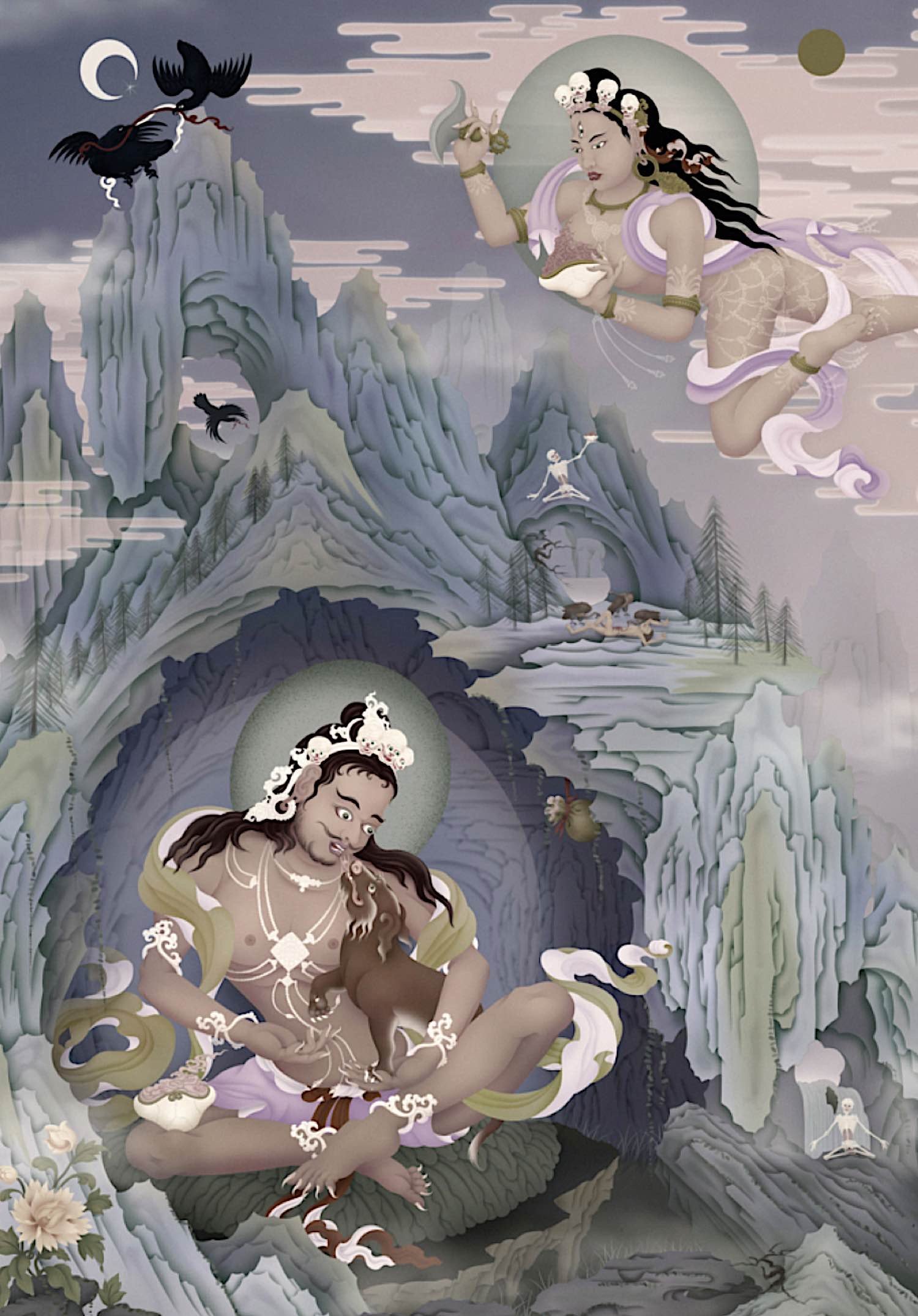 Kukkuripa Mahasiddha and his dog, who was in fact a Dakini (seen in the sky after her transformation). For the story of Kukkuripa and his dog, see the inset story below. Painting by Ben Christian Jampay Dorje. Prints of this wonderful painting are available from Dakini as Art>>
Kukkuripa Mahasiddha and his dog, who was in fact a Dakini (seen in the sky after her transformation). For the story of Kukkuripa and his dog, see the inset story below. Painting by Ben Christian Jampay Dorje. Prints of this wonderful painting are available from Dakini as Art>>
In Mahayana, sacred animals are even more vital — most famously represented in the “Four Dignities” or directional sacred animals. In Vajrayana Buddhism, deities take on symbolic forms as powerful animals (such as Lion-Faced Dakini or horse-headed Hayagriva) or have power animals as attendants and mounts.
In this feature, we cover them most of them, with their associated symbolism, practices and deities. Most famous of these, are the four directional dignities, or sacred animals of Buddhism (often associated with Tibetan Buddhism and also Bhutan): Garuda, Snow Lion, Tiger and Dragon — plus sacred Raven in the center.
See our previous feature on these four directional dignities of Buddhism>>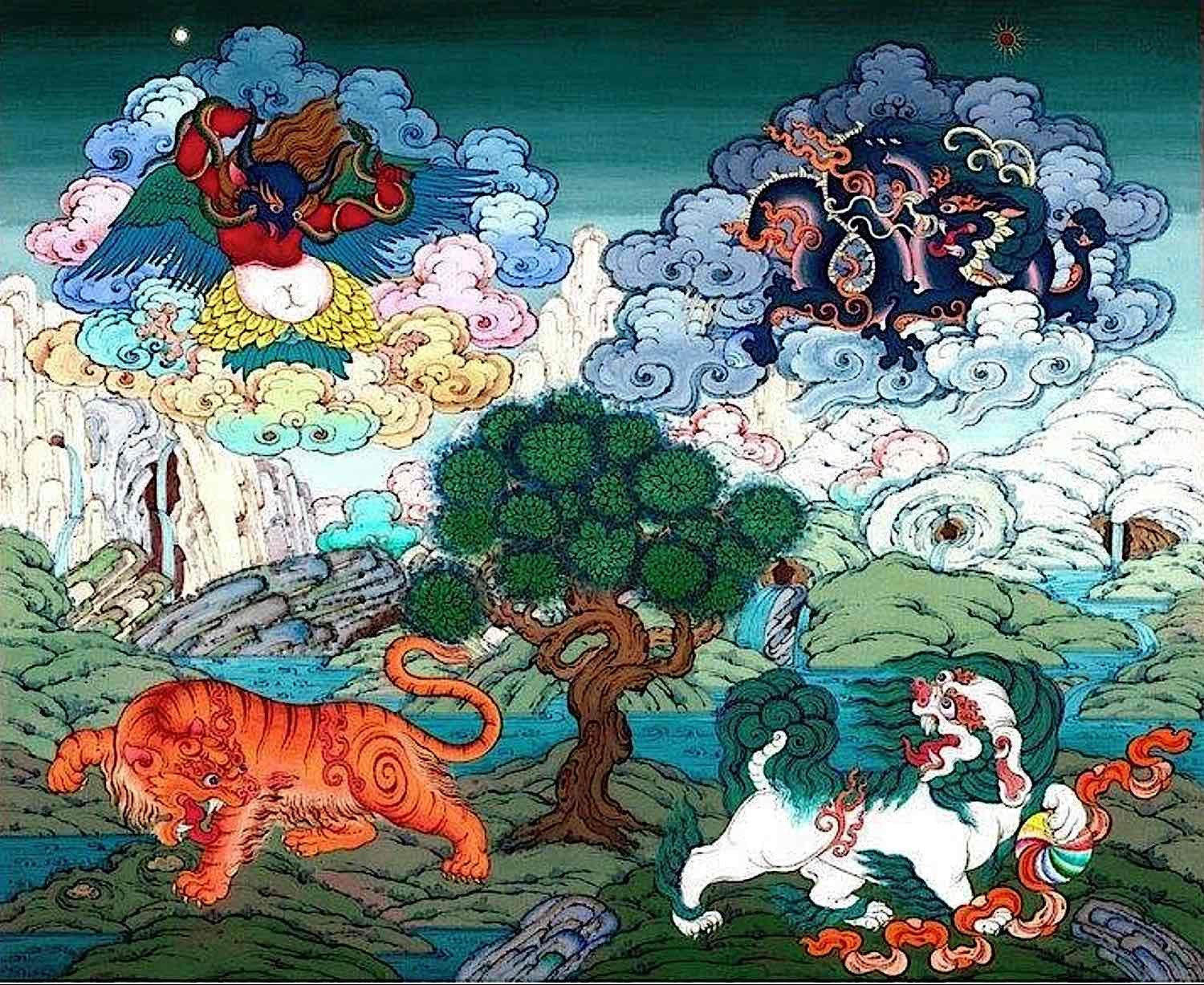 The Four Dignities in Tibetan Buddhism and the auspicious animals of Bhutan: Tak (Tiger) lower left Seng (Snow LIon) lower right, Cheng (Garuda) upper left and Druk (Dragon) upper right. These are four directional guardians with Garuda in the north, Snow Lion in the east, Tiger in the south and Dragon in the West. (In some regions, directions may be changed).
The Four Dignities in Tibetan Buddhism and the auspicious animals of Bhutan: Tak (Tiger) lower left Seng (Snow LIon) lower right, Cheng (Garuda) upper left and Druk (Dragon) upper right. These are four directional guardians with Garuda in the north, Snow Lion in the east, Tiger in the south and Dragon in the West. (In some regions, directions may be changed).Symbolism of power animals: profound and archetypal
In most cases, these animals signify an important aspect of practice, and tap into “universal consciousness archetypes” — as described by Carl Jung, the noted psychologist.
For instance, in the case of two example deities — Hayagriva (a wrathful form of Avalokiteshvara) with Vajravarahi (a wrathful form of Tara) — represent in symbolic terms:
Hayagriva with a horse emerging from the top of his head: the loud neigh of a horse is the power of Dharma speech to overcome obstacles and the activity of the Buddhas (horses represent wind). Vajravarahi with a pig’s head emerging from the top of her head: represents overcoming ignorance.In this special feature, we will take a closer look at some of these sacred animals and what they represent as archetypes. By understanding the symbolism behind these creatures, we can gain a deeper understanding of the teachings of Tibetan Buddhism, the symbolism of the Enlightened Deities, and core concepts in Mahayana Buddhism.
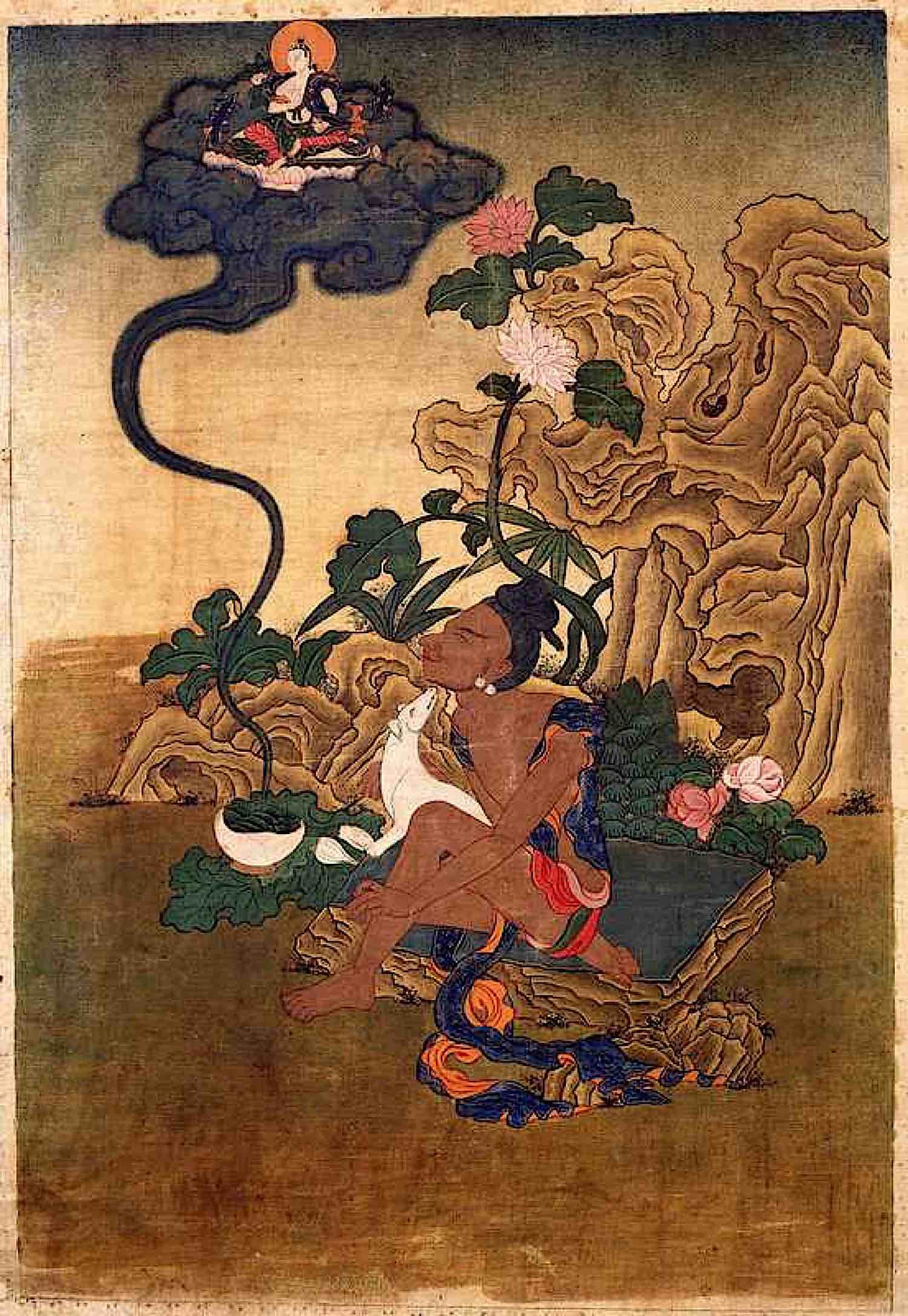 Kukkuripa looks down from heaven and sees his white dog who is pining away, missing him so terribly. He returns to her, and she transforms into a Dakini!
Kukkuripa looks down from heaven and sees his white dog who is pining away, missing him so terribly. He returns to her, and she transforms into a Dakini!
Kukkuripa Mahasiddha: realizations from his dog!
Tibetan Buddhism is full of lovely and profoundly meaningful stories of the power of animals. An all-time favorite is the story of great sage Kukkuripa, the Mahisiddha who found Enlightenment with his dog!
As the story goes, after years of practice, to reward Kukkuripa’s great accomplishments, the gods of the thirty-three divine heavens acknowledged Mahasiddha Kukkuripa’s accomplishments and welcomed him with open arms, treating him to an abundance of luxurious delights. Yet whenever he remembered his faithful white canine companion that stayed behind at the cave, he longed for her presence so badly that it almost drove him to depart from this sumptuous paradise—though in the end they always managed to persuade him otherwise.
As he gazed down from the heavens, he saw his beloved pet had become thin and sorrowful. It was then that he determined to come back to the cave. When both master and pup were reunited, joy filled their hearts as seemingly out of nowhere a dakini appeared in place of the dog after being scratched by her master’s hand!
This mysterious figure explained to him there are things more valuable than temptation which can lead you towards understanding your true self – granting him realization at long last.
 Kukkuripa Mahasiddha and his dog, who was in fact a Dakini (detail from full image above.) For the story of Kukkuripa and his dog, see the inset story below. Painting by Ben Christian Jampay Dorje. Prints of this wonderful painting are available from Dakini as Art>>
Kukkuripa Mahasiddha and his dog, who was in fact a Dakini (detail from full image above.) For the story of Kukkuripa and his dog, see the inset story below. Painting by Ben Christian Jampay Dorje. Prints of this wonderful painting are available from Dakini as Art>>
Symbolism with a core truth
You can view this story — as with this entire discussion on Power Animals — as a “relative reality” and core truth, or you can simply view the story as symbolic — that perhaps Kukkuripa never left his cave, except in his mind. Neither view matters. The key point is that we can find realizations in nature, in our compassion for sentient beings. We can also understand why animals are considered sacred and powerful in Buddhism.
Now, when you think of a dog and Enlightenment — you’ll instantly think of an Enlightened Dakini and Kukkuripa!
Sacred animals in Tibetan Buddhism — the significance of power animals
Tibetan Buddhism is a sacred and mysterious tradition that focuses on the “true nature of reality.” As a practice, this means, in general terms, through meditating with all of the senses through elaborate and meaningful visualizations. The term “visualization” is all-encompassing — not just meditating on appearance, but also sound, smell, taste, and touch.
This is especially emphasized in the wide incorporation of universal symbols — again visual, audible, scent, taste and touch. Even the offerings, symbolically presented to Enlightened deities, cover all of the senses: water and food for taste, flowers for visual, incense for scent, and so on.
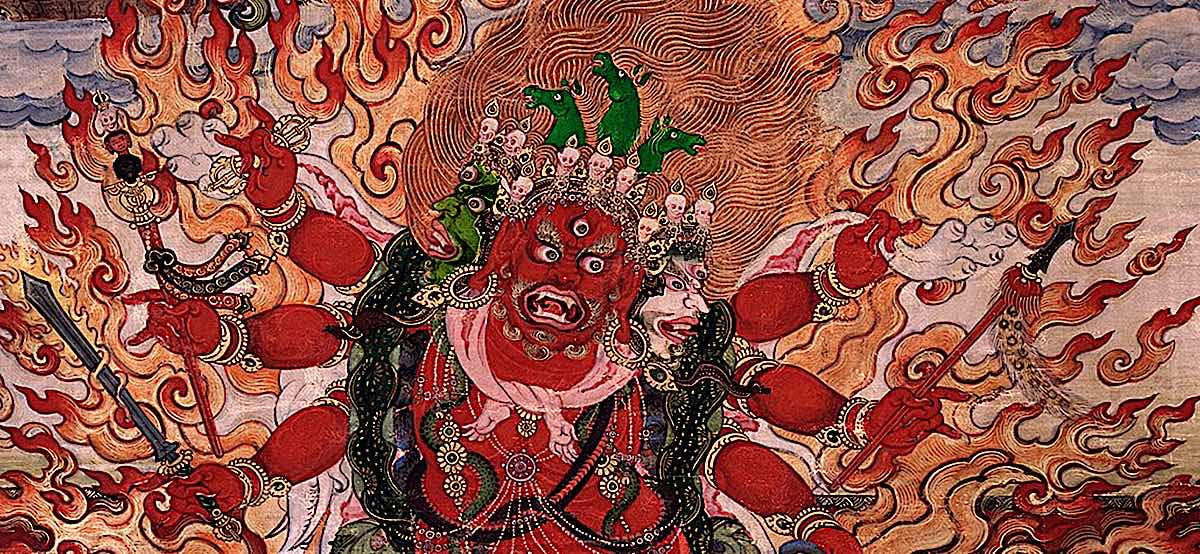 Hayagriva Sandrup closeup with three green horse heads is supreme Heruka (wrathful hero) of the Amitabha Family.
Hayagriva Sandrup closeup with three green horse heads is supreme Heruka (wrathful hero) of the Amitabha Family.
Nowhere is this more emphasized than in the ever-present symbols of “power animals.” Nearly every Enlightened Buddha, Bodhisattva and Protector in Vajrayana features at least one animal — at the very least as a “mount” or on the throne. Shakyamuni Buddha is associated with many power animals in early Sutta and Sutra: elephants, snakes (nagas), lions and many others.
Certain deities associate with specific animals
Especially in Vajrayana, all of the most powerful enlightened beings have associated themselves with certain animals — notably, the powerful individuals are known as ‘protector deities’ or Dhrtarastras — but equally with all Buddhas and Bodhisattvas.
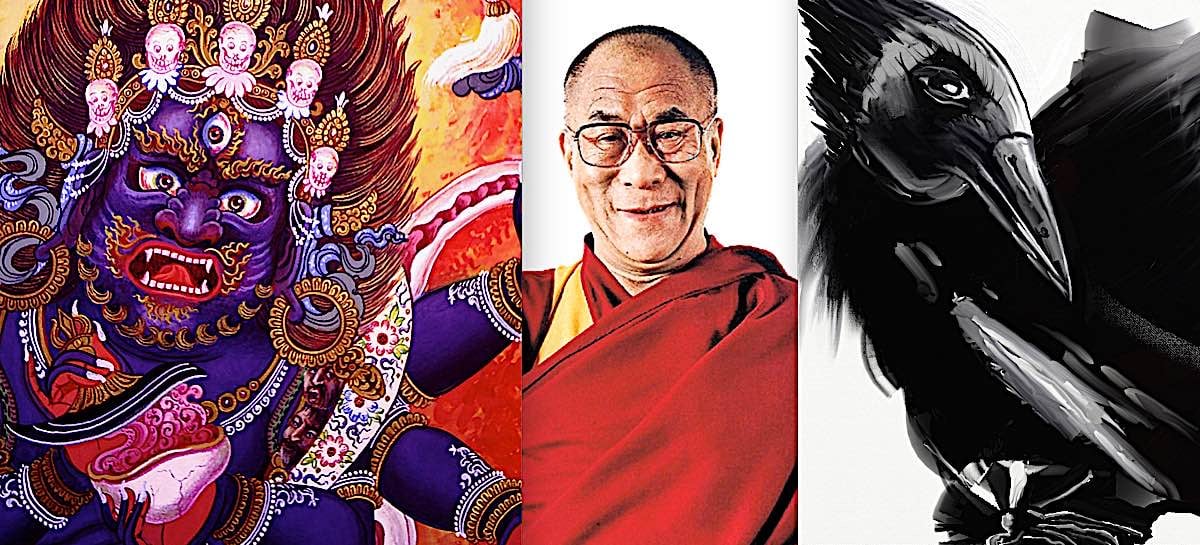 Stories of Black Mahakala and the Dalai Lamas feature miraculous crows. For a feature with charming stories see>>
Stories of Black Mahakala and the Dalai Lamas feature miraculous crows. For a feature with charming stories see>>
Crow, for example, is known to be the power animal of Mahakala – one of Tibetan’s highest-ranking protector deities. Over centuries, Crow has come to symbolize protection and the transformation of obstacles into opportunities brought forth by Mahakala’s grace whilst simultaneously invoking us all to follow our own spiritual guidance.
Another famous example is Yamantaka, who sometimes features a buffalo face.
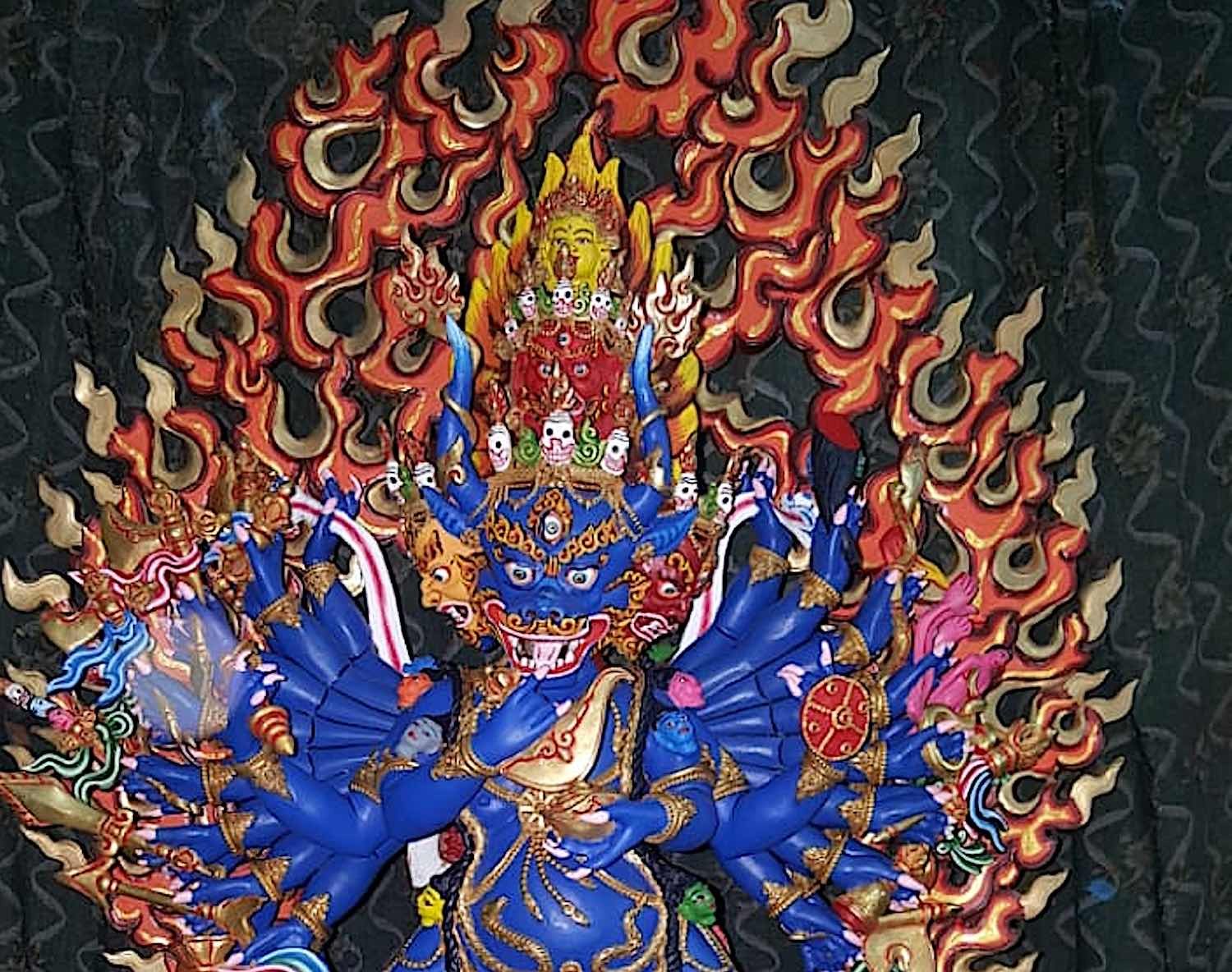 Stunning master-crafted and painted statue of Yamantaka with the central face as a buffalo by Nepal’s Best Statues. For an interview with Nepal’s best statues artisan, see>>
Stunning master-crafted and painted statue of Yamantaka with the central face as a buffalo by Nepal’s Best Statues. For an interview with Nepal’s best statues artisan, see>>
Come along with us now, as we explore many of the power animals of Tibetan Buddhism and Vajrayana and their significance. We can’t cover them all here, but we’ll certainly introduce the most popular ones — first, in the well-mapped out correspondences between sacred animals and Buddhas, and later, in brief, as a light summary of “sacred animals around the world.”
A comprehensive list of Power Animals
Bear
The consort of the shielder Begtse, known as ‘Goddess of Life’, proudly rides atop a bear. Kshetrapala, one of Shadbhuja Mahakala’s fiercest five escorts, is also typically found mounted upon an absurdly courageous bear. [1]
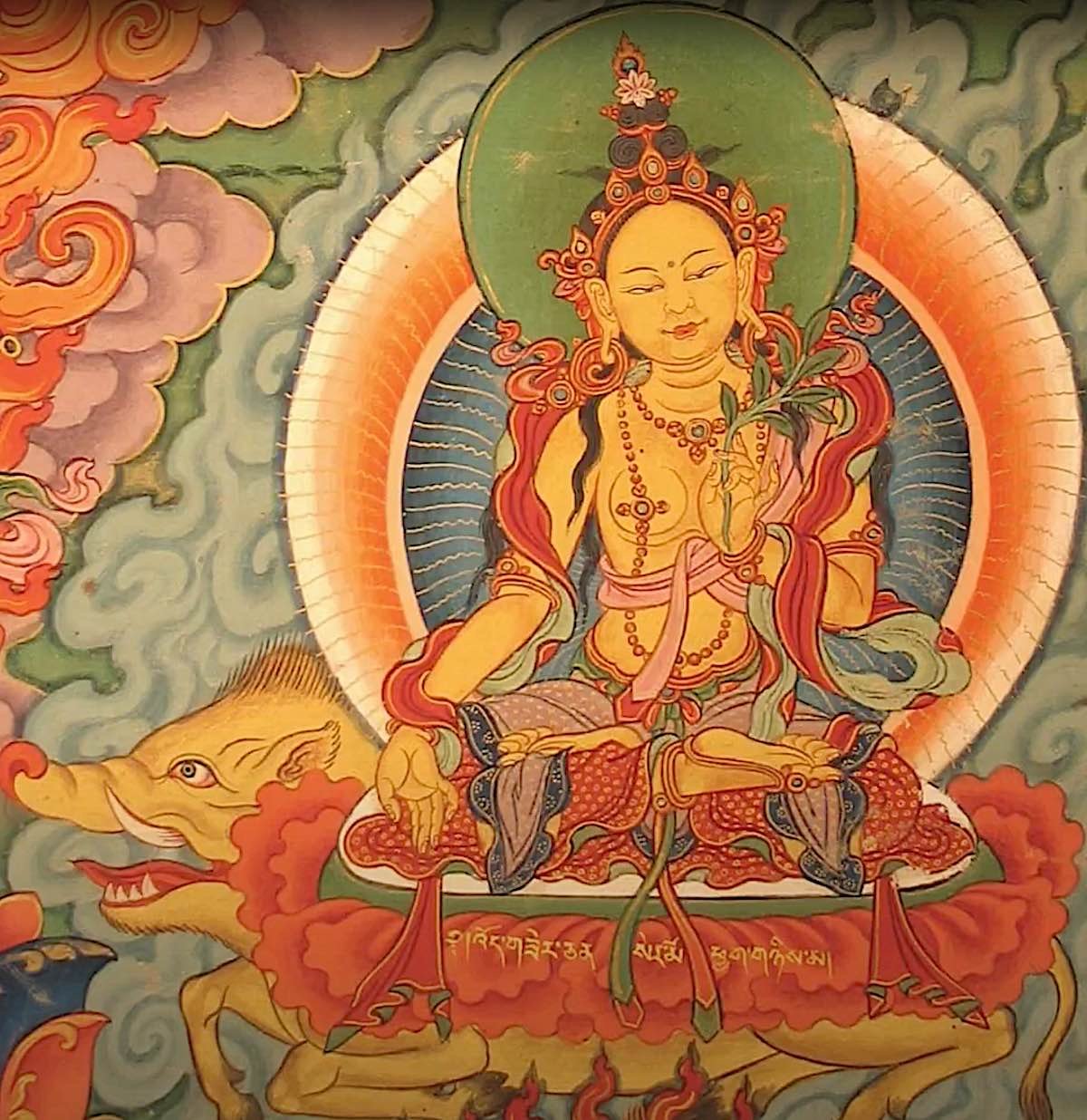 Marici Goddess of the Dawn is the “enemy of the Maras” and an important Mahayana and Vajrayana Enlightened Deity, an aspect of Tara. Himalayan Art Project image. For a feature on Marici, see>>
Marici Goddess of the Dawn is the “enemy of the Maras” and an important Mahayana and Vajrayana Enlightened Deity, an aspect of Tara. Himalayan Art Project image. For a feature on Marici, see>>
Boar
Vajravarahi, Varaha, Marichi, Purba Drugse Chempa and Bhudeva/devi are part of the Medicine Buddha’s entourage. Wrathful Padma Shavari from the Treasure Tradition stands atop a nine-faced boar–all these deities showcase either a boar face or straddle on an animal resembling one. To add to that grandeur, some stand upon thrones supported by this mighty creature.
For a feature on Vajravarahi Vajrayogini, see>> For a feature on Marichi, see>>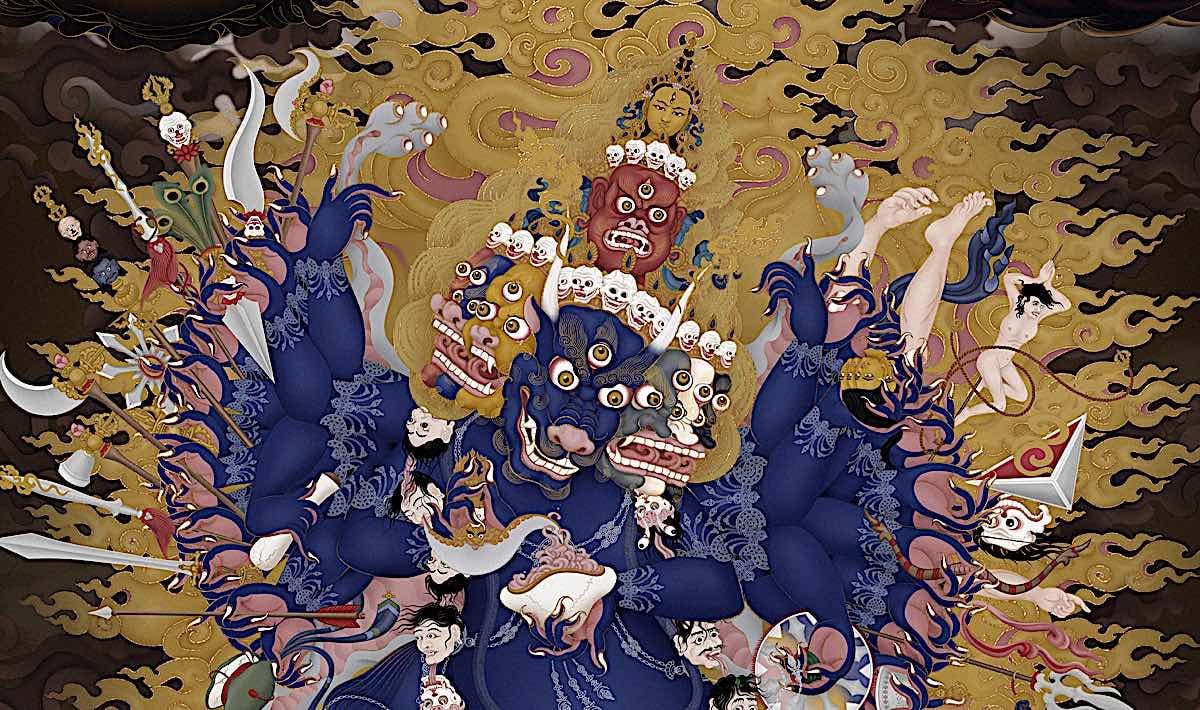 Arguably the most ferocious of wrathful yidams in Manjushri’s form Solitary Hero Yamantaka with 9 faces, 34 arms, 16 legs treading on gods, men and beasts alike. Detail from a magnificent Tangkha by Ben Christian (Jampay Dorje).
Arguably the most ferocious of wrathful yidams in Manjushri’s form Solitary Hero Yamantaka with 9 faces, 34 arms, 16 legs treading on gods, men and beasts alike. Detail from a magnificent Tangkha by Ben Christian (Jampay Dorje).
Buffalo
Vajrabhairava (Yamantaka), Krishna Yamari, Rakta Yamari and Yama Dharmaraja are all deities that bear a buffalo face or stand atop one. The Jataka Stories even feature moral tales related to this iconic animal.
For a feature on Yamantaka Vajrabhairava, see>>Camel
The Queen of Winter from the Shri Devi Magzor Gyalmo retinue rides atop a camel. Black camels are often depicted in Mongolian ‘kangdze’ offering paintings.
For a feature on Shri Devi Magzor Gyalmo and Palden Lhamo, see>>Cow
Intricate sculptures by Choying Dorje, the 10th Karmapa, depict a Lokeshvara figure atop a cow – which is symbolic of both Siddha Goraksha’s profession as cow herder and Krishna Avatar of Vishnu’s association with cows and Gopi girls.
Crow
Mahakala is often called “The Great Black” and is strongly associated with crows. There is the famous story of the three men in black and the crows associated with Mahakala’s monastery.
For a full feature on Mahakala and crows, see>> [Soon to be a video on our Youtube Channel!]Mahakala is often accompanied by crows or ravens – the Kakamukha Mahakala has a crow head, and the Nyingma protector deity Rahula even more impressively features a crow at its very highest point. More surprisingly still, Marichi in one painting showcases an artistic sun marked with a three-legged crow! The Dalai Lama is strongly associate with crows.
See the Dalai Lama’s own story about the crows in this feature>>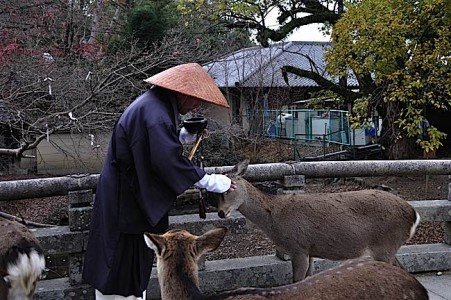 Japanese monk shares a tender moment with a deer.
Japanese monk shares a tender moment with a deer.Deer
The Buddhist Wheel of Dharma is typically accompanied by two kneeling deer, and the listed bodhisattvas and deities are all donning a krishnasara or deerskin on their left shoulder. Shakyamuni Buddha delivered his first teachings in Deer Park, surrounded by disciples, and deer! Shavaripa from the Eighty-four Mahasiddhas stands out among them as he’s often depicted as a deer hunter, while there’s no shortage of stories involving these majestic animals in Jataka Tales. Indeed, they have been an integral part of Buddhism since its inception!
For a video feature on Buddha’s first teaching in Deer Park, see>>Dog
The famous mahasiddha Kukkuripa has earned the nickname ‘dog person’ (see the story in our introduction!). Many of the Mahakalas accompanied by ebony four-legged sidekicks!
Donkey
Both Chakrasamvara and Hevajra manifest in one form with a donkey head. Shri Devi also rides atop a donkey.
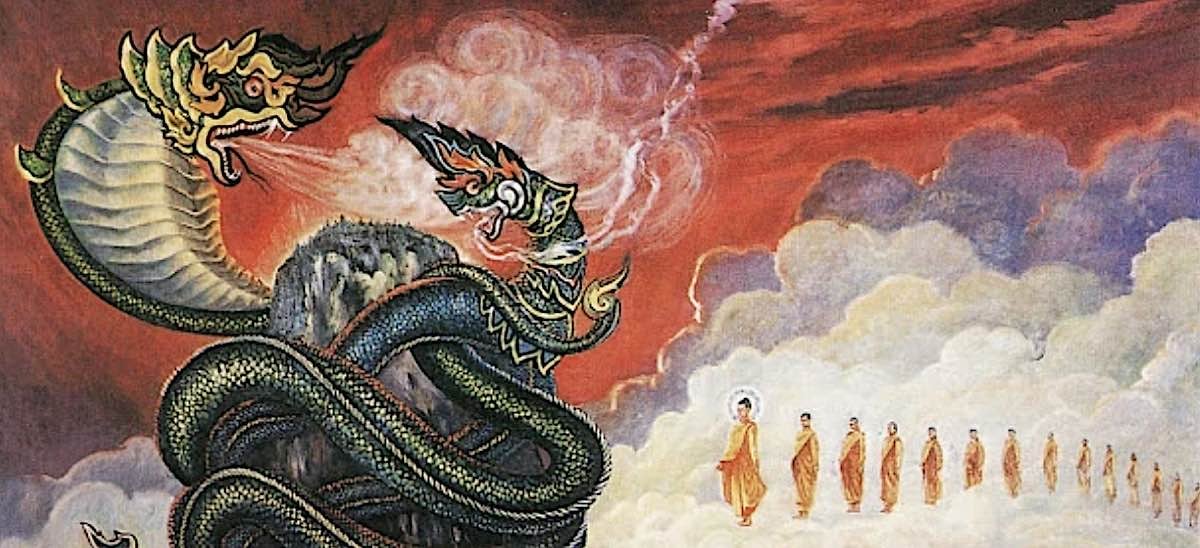 Buddha teaches the Dragon King, sutra story. For a feature on dragons in Buddhism, see>>
Buddha teaches the Dragon King, sutra story. For a feature on dragons in Buddhism, see>>
Dragon
The Drukpa Kagyu Buddhist Tradition is named after this majestic mythical creature — as is Bhutan itself! “Druk” literally means dragon. (Sometimes spelled Drugpa in transliteration.) Majestic White Jambhala and one of the Tseringma Sisters are traditionally depicted riding atop a dragon, signifying its importance in religious texts. Green Tara and Guanyin (Kuan Shi Yin) are strongly associated with dragons. Dragons are common themes on prayer flags around the world.
See our feature “What do you do if you see a dragon in your bedroom” and all about dragons in Buddhism>>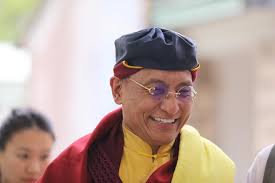 12th Gyalwang Drukpa of the Drukpa lineage (Drukpa literally means Dragon.)
12th Gyalwang Drukpa of the Drukpa lineage (Drukpa literally means Dragon.)
Elephant
Famously, Ganapati/Ganesha is renowned for having the head of an elephant, which carries profound symbolism. (Ganesha is both an Enlightened protector emanation of Avalokiteshvara and a Hindu god.)
For a full feature on Buddhist Ganesha, see>>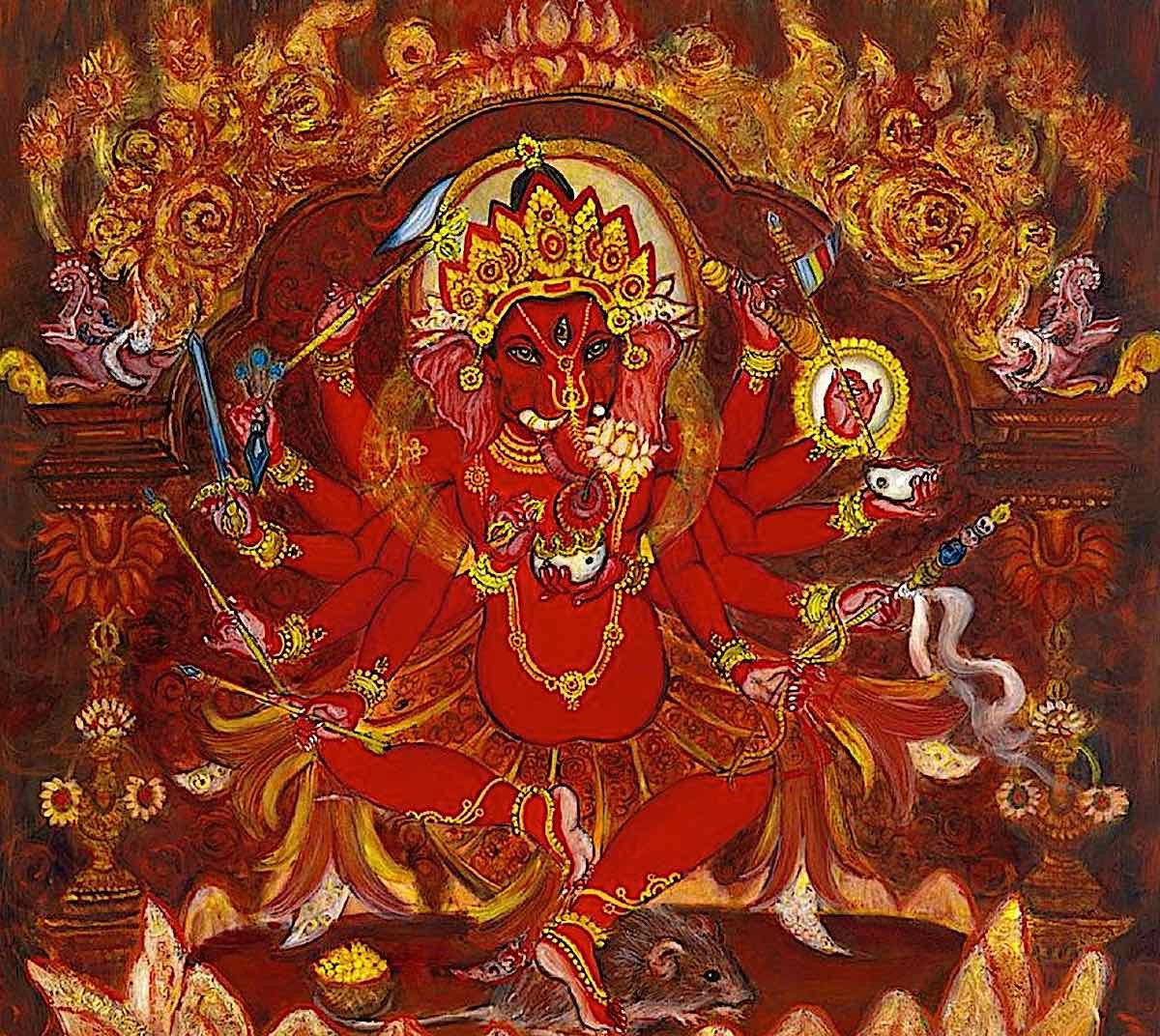 12-armed Ganesha or Ganapati, also known as Maha Rakta Ganapati, remover of obstacles. For a full feature on Ganesha in Buddhism, see>>
12-armed Ganesha or Ganapati, also known as Maha Rakta Ganapati, remover of obstacles. For a full feature on Ganesha in Buddhism, see>>
Akshobhya Buddha sits on a majestic throne, supported by an elephant. Shadbhuja Mahakala and one incarnation of Bhutadamara Vajrapani from the Charya Tantras are both seen standing atop their own elephants in iconography.
In Chinese Buddhist artworks, it’s even more common to find Bodhisattva Samantabhadra riding upon an elephant!
Fish
Among the Eight Auspicious Symbols of Buddhism, the two fish are particularly lucky. Tilopa is usually seen holding a fish in his left hand, and Luipa typically holds entrails from a fish — both with deep, symbolic meaning. Minapa, one of eighty-four Mahasiddhas according to Abhayadatta’s system, stands on top of a big fish; additionally, Vishnu’s Matsya Avatar takes the form of an aquatic animal too.
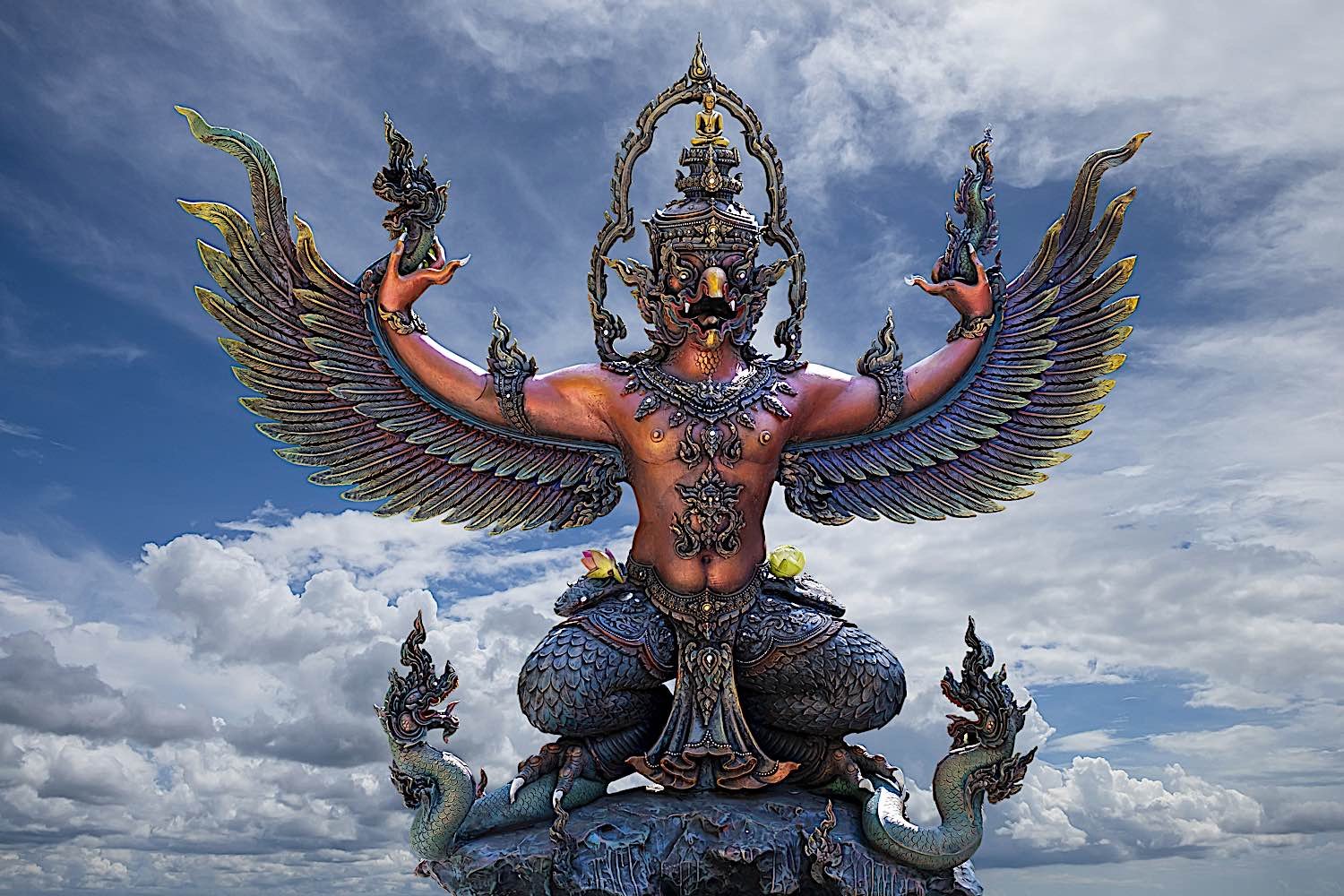 Garuda’s are awe-inspiring and powerful. They are the power of wind and air, typically the guardians of the north and Green Tara/ Amoghisiddhi’s realm.
Garuda’s are awe-inspiring and powerful. They are the power of wind and air, typically the guardians of the north and Green Tara/ Amoghisiddhi’s realm.
Garuda
King Garuda, half bird and half man, is himself a deity in Tibetan Buddhism, and when combined with the practices of Vajrapani and Hayagriva is a famous healing practice. Vishnu has Garuda as his mount, vehicle, companion. Nagas are often clutched in the talons or beaks of Garuda birds. He is also represented at the top of the Torana (throne back).
For a video feature on Vajrapani Hayagriva King Garuda, see>>Goat
Dorje Legpa — in some forms — rides a goat rather than a lion. Damchen Garwa Nagpo rides on a goat.
Goose
Brahma, Chandra (moon), Sarasvati. All of these deities have the goose as a mount. In early torana depictions, throne back, the goose is a common symbol.
Video on Hayagriva with horse heads (and Vajravarahi with pig’s head):
Horse
Lord Hayagriva — the Heruka form of Avalokiteshvara and Amitabha — has either one or three horse heads atop his own body depending on the visualization. Meanwhile, Ratnasambhava sits atop a throne carried by a horse. Marichi rides upon a steed in some forms or practice. Multiple Jataka Stories are based on horses!
Black Mahakala is usually associated with the black horse — and a dream featuring a black horse is very auspicious! Bernagchen Mahakala and his consort ride up high on their ebony stallion. Famously, the “wind horse” represents the wind-activity aspect of Buddhism — representing not only wish-fulfillment, but also prayers of compassion — and for this reason is featured on many prayer flags.
Kirtimukha
Many Buddhist deities — and many teachers in public teachings — are seated on a throne with a throne back (Torana) featuring either a Kirtimukha, or “face of glory,” and/or a Garuda.
Leopard
Many female deities embodying wrathful energies are clad in a leopard skin skirt, whilst their male counterparts don such garments made from the pelt of a tiger.
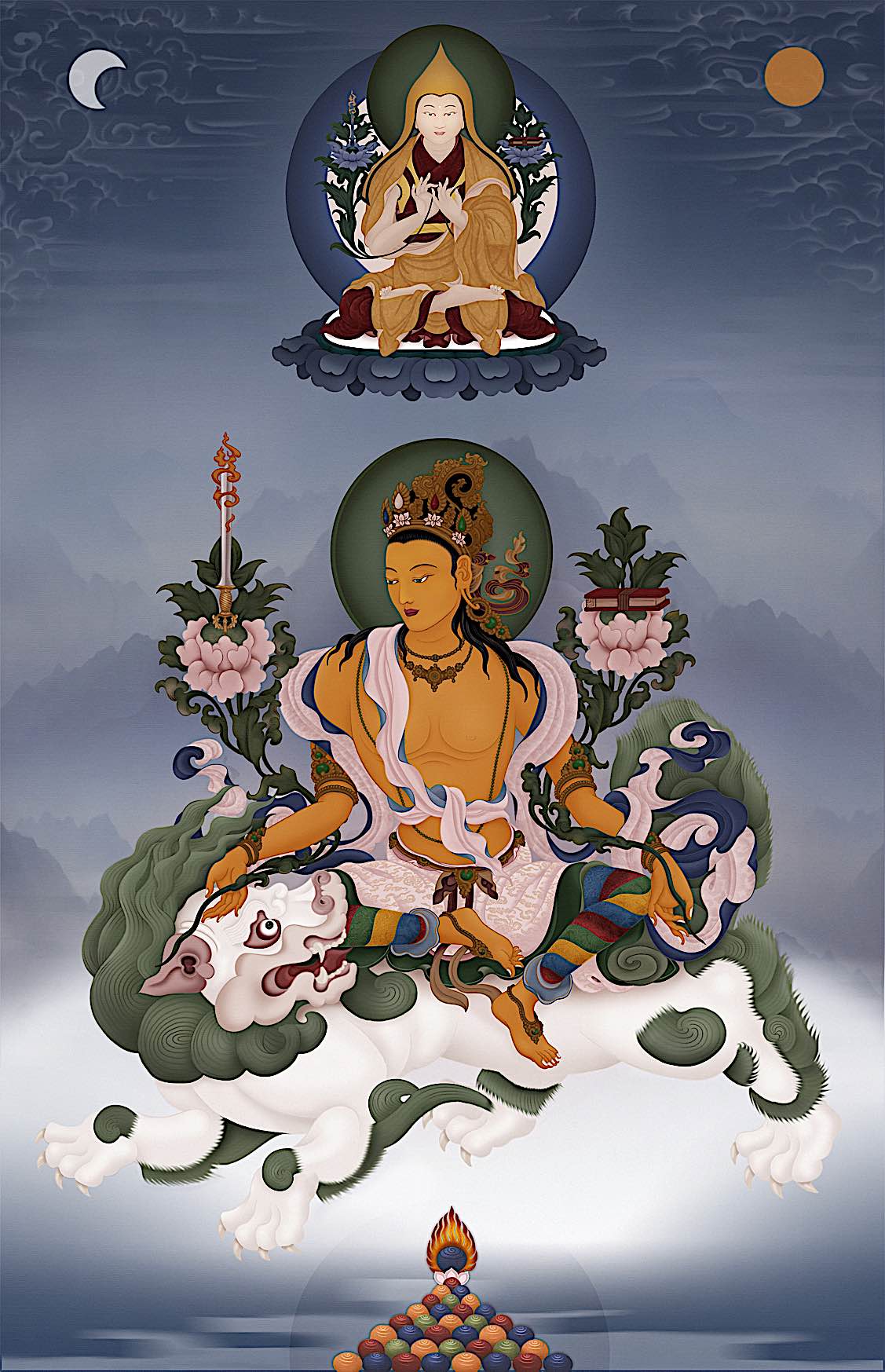 Another stunning tangkha from Jampay Dorje (Ben Christian) — this time with Manjushri on the Snow Lion.
Another stunning tangkha from Jampay Dorje (Ben Christian) — this time with Manjushri on the Snow Lion.
Lion or Snow Lion
There are three general ways deities are depicted with lions or snow lions:
(1) seated atop a lion-supported throne (often four or eight)
(2) having a lion face, for example Lion-Faced Dakini Simhamukha
(3) Riding atop a lion.
Shakyamuni Buddha and Vairochana Buddha are both seated atop a lion-supported throne with Tara (eight fears) acting as their protector. Simhanada Avalokiteshvara, Manjushri, and the 2nd retinue attendant for Shri Devi Magzor Gyalmo all have a lion face. Shingkyong and his consort in Bernagchen Mahakala’s retinue also possess lion faces. Vishnu is seen taking on his Narasimha Avatar form which is half man and half lion. Last but not least are Pehar Gyalpo, Dorje Legpa, Tseringma, and Vaishravana – each of whom rides atop an awe-inspiring snow lion!
For a feature on Simhamukha, see>>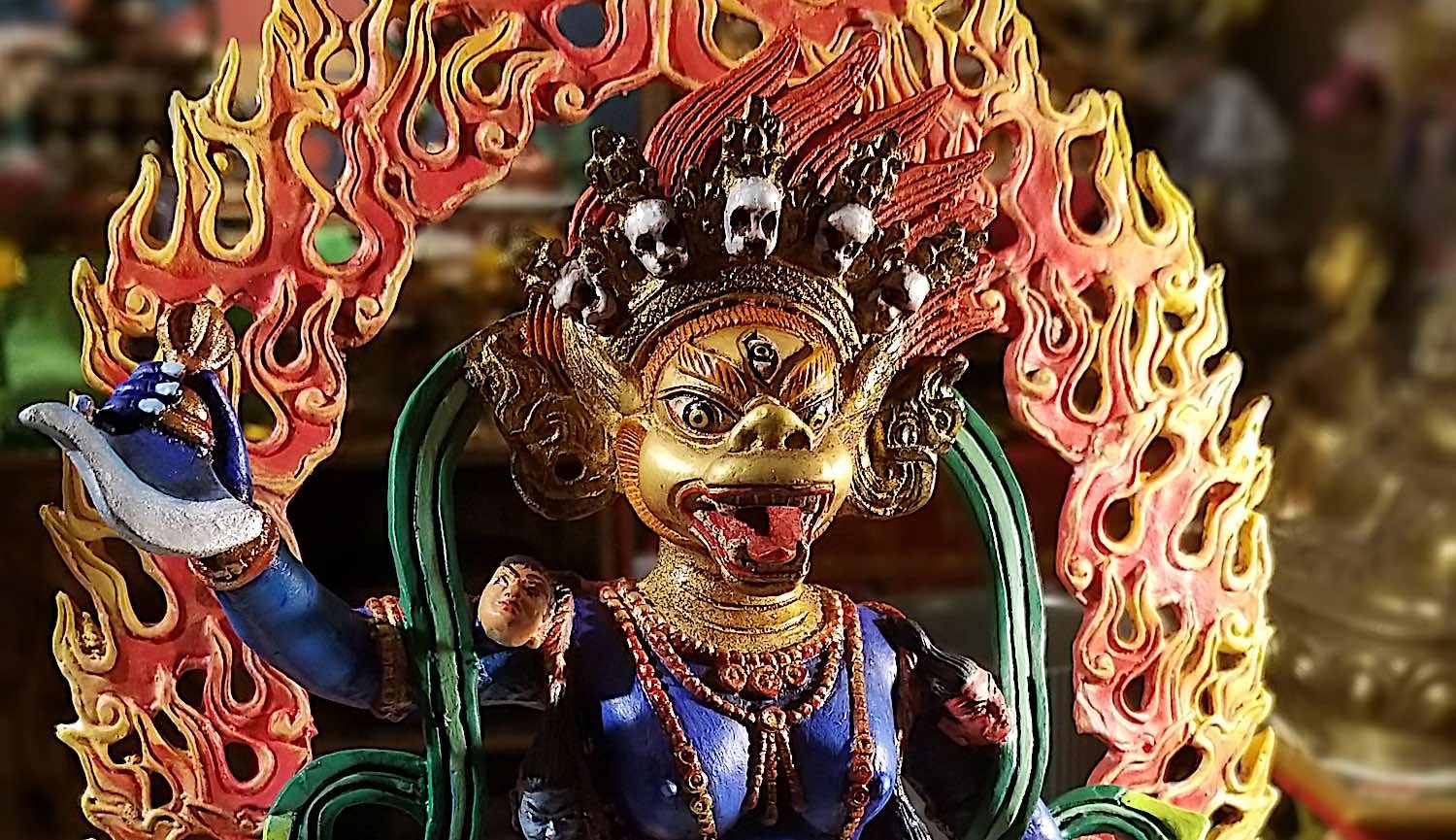 Simhamukha or Senge Dongma, the Lion-Faced Dakini . This is a statue hand thangka painted as an act of devotion by Buddha Weekly’s creative director Kam Wai Yu. For a feature on Simhamukha, see>>
Simhamukha or Senge Dongma, the Lion-Faced Dakini . This is a statue hand thangka painted as an act of devotion by Buddha Weekly’s creative director Kam Wai Yu. For a feature on Simhamukha, see>>
Makara
Makara-faced Dakini, one of Palden Lhamo’s two principle female attendants, leads the mule of Shri Devi Magzor Gyalmo. Throne Back and temple roofs feature Makaras.
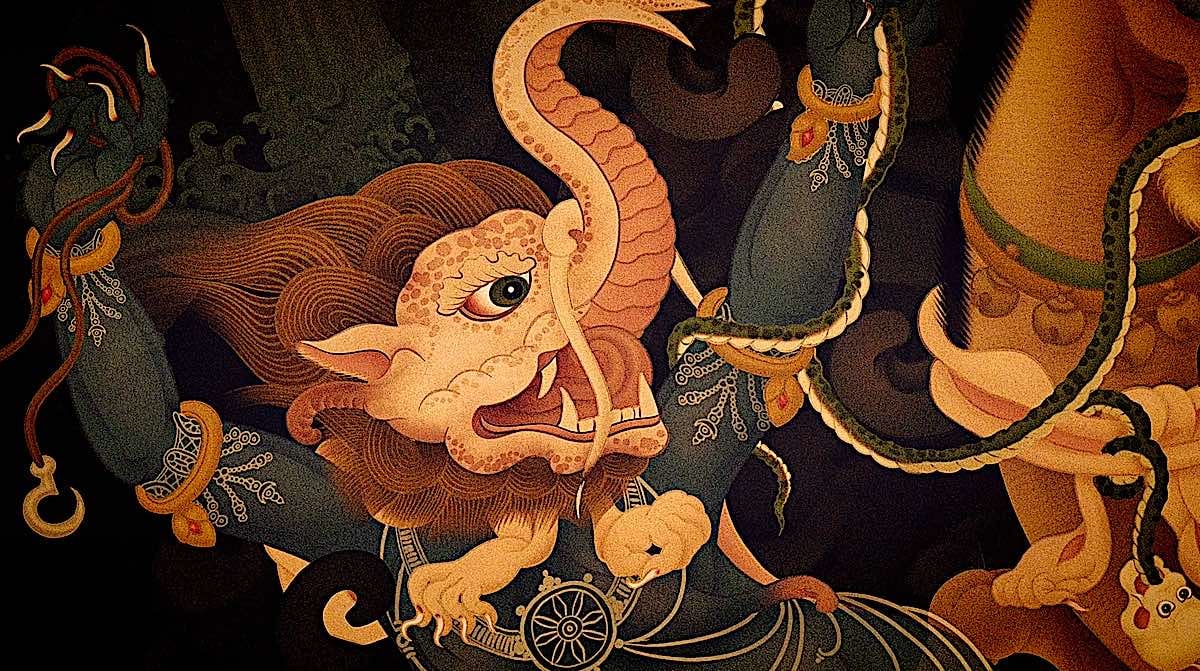 Painting of Makara-Faced Dakini Makaravaktra, who is an attendant of Palden Lhamo and who rescues us from dangers of the underworld. For a feature on Palden Lhamo, see>>
Painting of Makara-Faced Dakini Makaravaktra, who is an attendant of Palden Lhamo and who rescues us from dangers of the underworld. For a feature on Palden Lhamo, see>>
Mongoose
Jambhala, Vaishravana, Twelve Yaksha Kings (Medicine Buddha), Arhat Bakula. All of these figures hold a mongoose, generally in the left hand — often spilling jewels from its mouth the signify wealth and prosperity practices (in the case of the wealth deities.)
 Buddha, Monkey King (center) and the legendary monk in Journey to the West.
Buddha, Monkey King (center) and the legendary monk in Journey to the West.
Monkey
Lord Hunaman is sometimes found in Buddhism, especially in some Mahayana practices.. The Monkey King in the epic Journey to the West helped the monk on his Dharma mission to bring back scriptures from India to China. Ganapati/Ganesha, Bernagchen Mahakala and Tsiu Marpo all have monkeys as attendant figures. There are several Jataka Stories about monkeys.
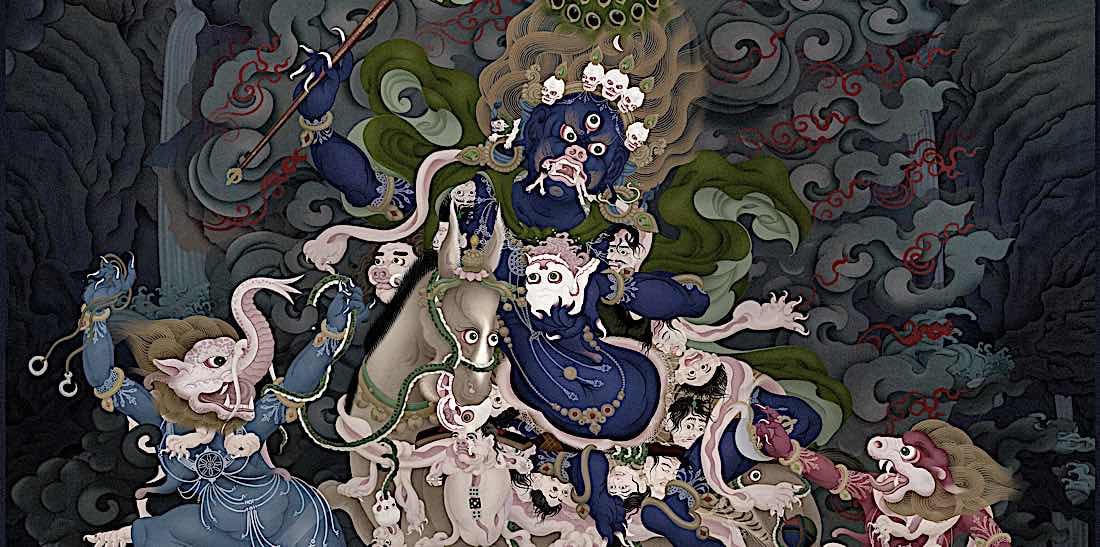 Stunning image of Palden Lhamo, the Queen of the End of War by Jampay Dorje (Ben Christian) riding a mule with an eye on his flank. She is accompanied by blue Makaravaka on the left; and red Simhavakra on the right.
Stunning image of Palden Lhamo, the Queen of the End of War by Jampay Dorje (Ben Christian) riding a mule with an eye on his flank. She is accompanied by blue Makaravaka on the left; and red Simhavakra on the right.
Mule
Shri Devi Magzor Gyalmo rides atop a mule with an eye in its flank (where it was struck by and arrow — as opposed to Shri Devi Dudsolma (with four arms) —who rides atop a donkey.
Video documentary by Buddha Weekly on Palden Lhamo:
Naga (also see Snake)
Nagaraja Buddha, Simhanada, Garuda, Manasa, Nagarjuna, and the Naga King are all linked to nagas. Many wrathful deities wear the Eight Great Naga Kings as decorations, such as for bracelets, anklets, belt, etc. Each are named and have a specific colour described in the literature. In Sutra, the Naga king protected Shakyamuni Buddha from the rain while he was meditating.
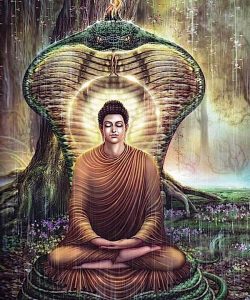 Buddha protected by the Naga King while meditating.
Buddha protected by the Naga King while meditating.
Peacock
Amitabha/Amitayus, Manjushri, Kumara/Karttikeya, may sit on a peacock, or peacock throne. Mahamayuri holds peacock feathers. The Siddha Shavaripa often wears a peacock cloak.
Pig
Marichi either may have a pig face or may appear in a chariot drawn by pigs, or sits on a pig, sow, or boar, although she sometimes rides a horse. A sow or pigs head appears sometimes arising from Vajravarahi’s head — representing she is overcoming ignorance.
Rabbit
There are several Jataka Stories about Shakyamuni Buddha in previous lives born as a rabbit.
Rat
Ganapati or Ganesha may ride a rat — or, sometimes he has a rat as an attendant.
Raven
Kakamukha Mahakala has a raven face and is called Raven-Faced Mahakala. He also has wings. Crows and Ravens are both sacred to Black Mahakala. Crows and ravens figure prominently in legends of Mahakala.
The Bhutanese Royal Crown has a raven head on the top — and ravens are one of the five directional animals of Bhutan. (For a feature on the five directional animals, see>>).
Sakya Tridzin Wangdu Nyingpo is sometimes depicted wearing a wrathful raven hat.
Rooster
Is often associated with Dorje Setrap, a protector. The Dragyab Monastery of Eastern Tibet maintains Dorje Setrab as their special protector. The place is also filled with chickens and roosters which are believed to be associated with Dorje Setrab. Marichi in one painting is depicted with a sun marked with a three-legged rooster (crow).
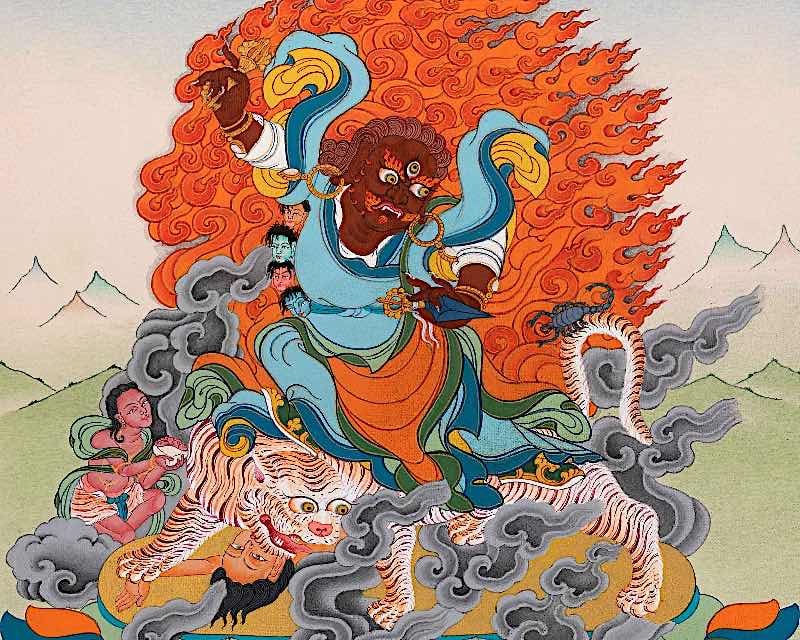 Guru Dorje Drollo, an emanation of Guru Rinpoche often holds a scorpion in hand. In this thangka the scropion is to our right in the wisdom flames.
Guru Dorje Drollo, an emanation of Guru Rinpoche often holds a scorpion in hand. In this thangka the scropion is to our right in the wisdom flames.Scorpion
Dorje Drolo — an aspect of Padmasambhava in Treasure Traditions — holds a scorpion in the left hand. Black Hayagriva has a scorpion attendant. Guru Dragpo and Guru Dragpur grasp a black scorpion in the left hand. Begtse Chen and some forms of Shri Devi hold aloft in the right hand a scorpion-handled sword.
Sheep
Trailokyavashamkara Lokeshvara, a special (and rare) form of Avalokiteshvara, stands on two sheep.
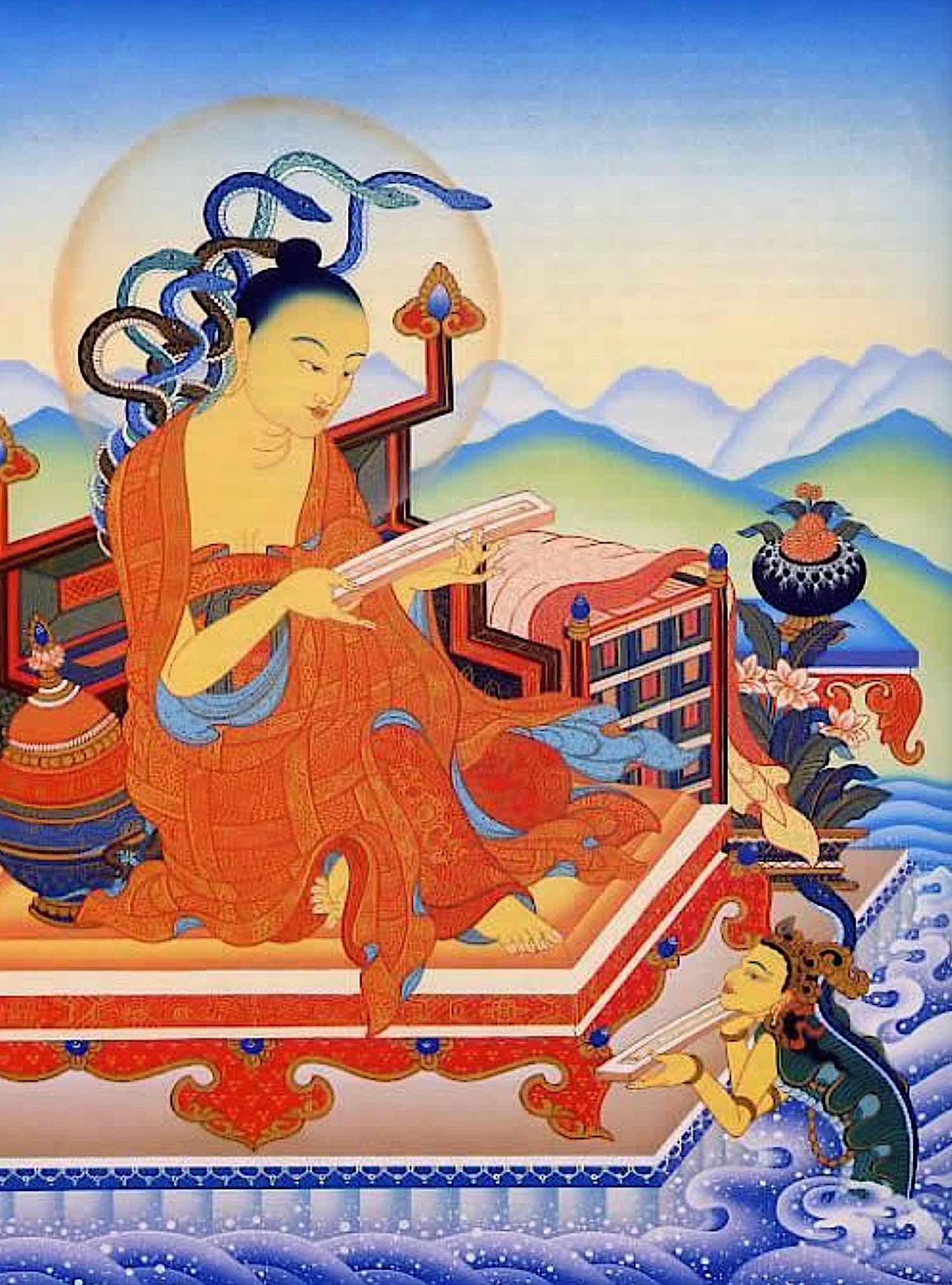 The sage Nagarjuna receiving sutras and Holy texts from the Naga King Varuna.
The sage Nagarjuna receiving sutras and Holy texts from the Naga King Varuna.
Snakes (also see Naga, above)
Hayagriva Sangdrup stands on the eight great snakes or nagas. Nagaraja Buddha has a hood of snakes above the head as does the Indian Buddhist siddha Nagarjuna. Manasa often holds a snake. One of the fears Tara protects against is snake bite. Most (or many) wrathful deities wear the Eight Great Naga Kings as decorations, such as for bracelets, anklets, belt, and other ornaments.
Snow Lion (see Lion)
Tseringma, chief of the five long-life sisters rides atop a snow lion. Snow lions are on thrones of Enlightened Beings. Snow Lion is one of the five animals of Bhutan.
Swan
Swan — or sometimes goose — can be the mount of Sarasvati. One form of the 21 Taras is sometimes mounted on a swan or goose.
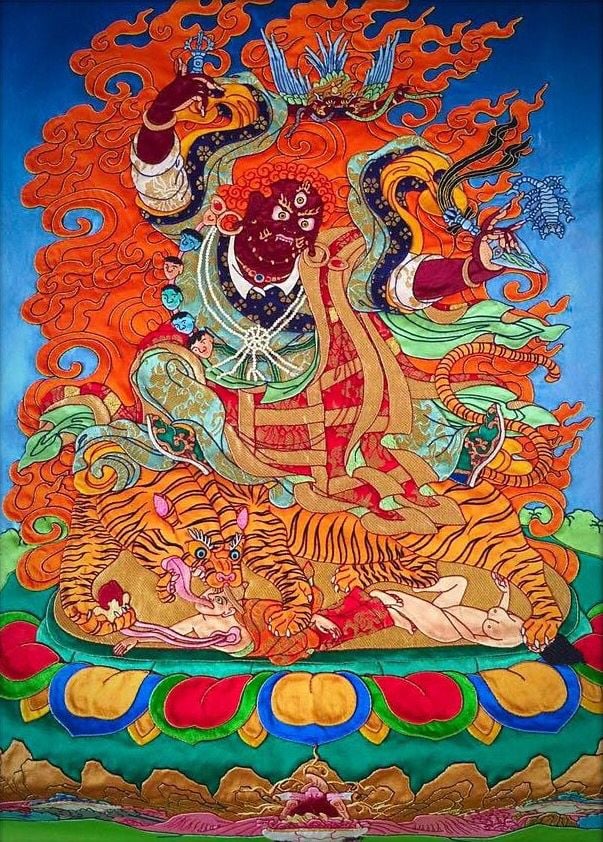 Tiger is especially well known as a magical protector, especially with his association with Guru Rinpoche. Dorje Drolo, the most wrathful of Padmasambavha’s manifestations, rides into Bhutan on the back of a magical tiger — who is none other than Lady Yeshe Tsogyal transformed. They land in Bhutan at the site of the Tiger’s Nest monastery.
Tiger is especially well known as a magical protector, especially with his association with Guru Rinpoche. Dorje Drolo, the most wrathful of Padmasambavha’s manifestations, rides into Bhutan on the back of a magical tiger — who is none other than Lady Yeshe Tsogyal transformed. They land in Bhutan at the site of the Tiger’s Nest monastery.Tiger
Another prayer flag figure and one of the five sacred animals of Bhutan. Both Dorje Drolo, a manifestation of Padmasambhava, and the renowned mahasiddha Dombi Heruka are often depicted standing or riding atop a pregnant tigress. Vyaghra-vahana, a form of Mahakala, stands on the back of a tiger (vyaghra means tiger). Dharmatala, the attendant to the Sixteen Arhats, is seen with a tiger. Male wrathful deities wear a tiger skin loin cloth or skirt.
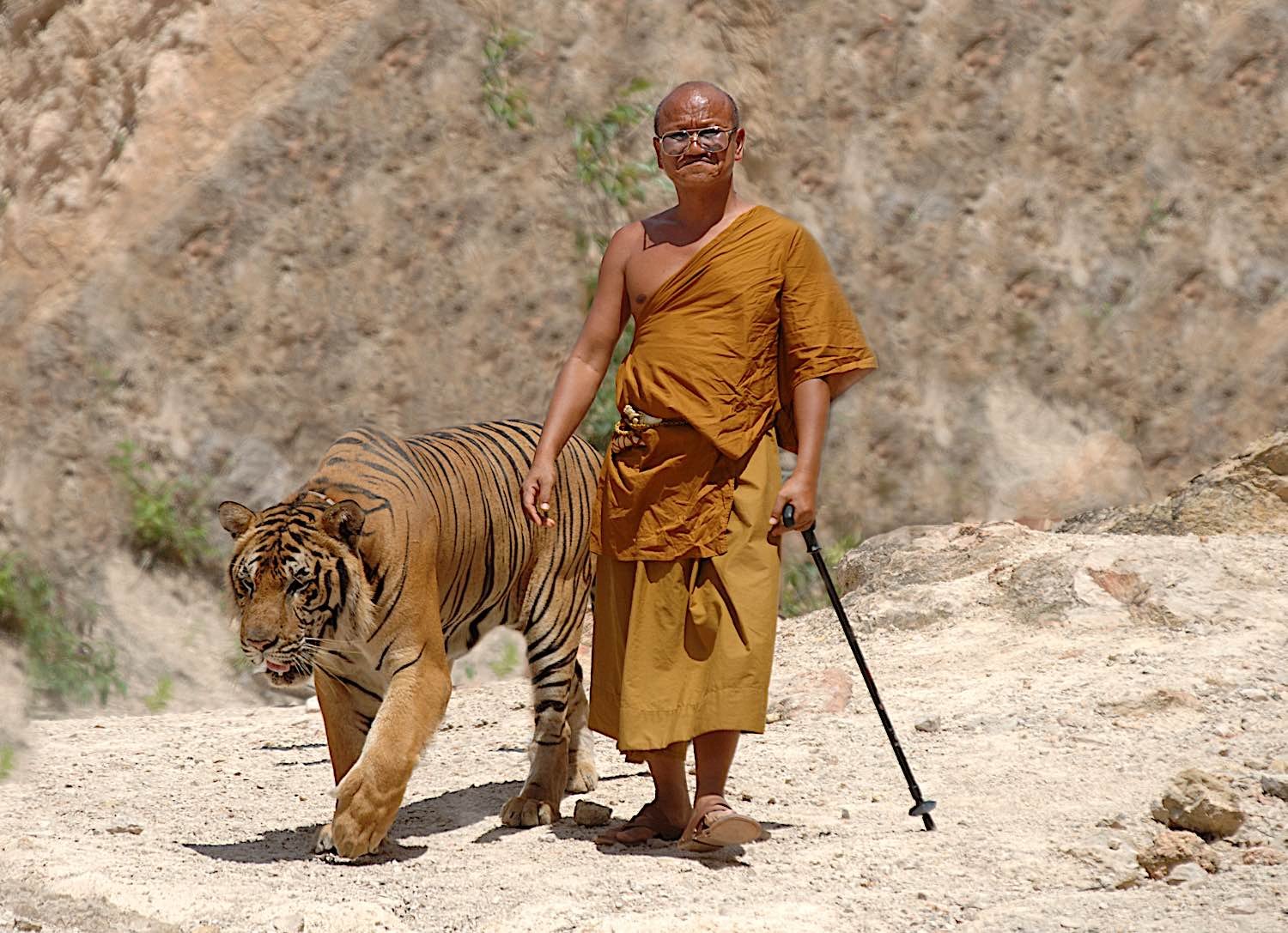 A Buddhist monk out for a walk with a Bengal Tiger in Kanchanaburi Thailand.
A Buddhist monk out for a walk with a Bengal Tiger in Kanchanaburi Thailand.
Tortoise or Turtle
Associated with Turtles are: Manjushri, Kurma Avatar, Sidpaho, Siddha Kurmapada.
Vulture
Vulture feathers adorn the hats or crowns of Padmasambhava, Dorje Lingpa, Rigdzin Pema Chogyal and Godemchen. Vultures play an important role in the sky burial ritual and represent the Dakinis.
Wolf
The son of the protector Begtse, ‘Lord of Life’, rides a wolf as his steed. Some forms of Ekajati in the Revealed Treasure Tradition hold a wolf in the left hand.
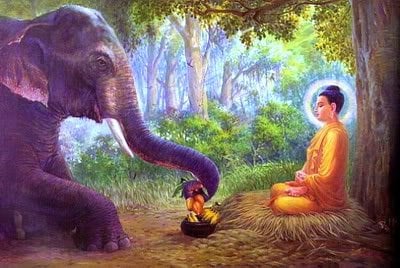 Buddha is often portrayed in stories and illustrations with animals.
Buddha is often portrayed in stories and illustrations with animals.
Around the world — sacred animals are found in most spiritual paths
From antelopes to yaks, numerous sacred animals are venerated in many cultures around the world. The antelope in particular is known to be a symbol of swiftness and grace, while bats are often associated with communication and good luck.
Bears have strong connotations with guidance, strength and mercy, whereas bees represent fertility and cooperation. Boars, buffaloes, camels and cows can represent protection, courage and abundance respectively, although crows have become notorious for warnings of death or danger. Dogs often stand for loyalty or guardianship and donkeys for stubbornness and humility.
Mythical dragons are renowned for their mythical power as are elephants for their wisdom, whereas fish can symbolize transformation or fertility depending on context. The garuda (or eagle) personifies warrior energy along with strength and tenacity while goats suggest lustful energy.
Geese may signify family unity or loyal love while horses indicate freedom. The leopard stands for courage in the face of danger alongside resilience whilst monkeys are occasionally seen as messengers between gods and humans.
Makaras symbolize unearthly power while mice stand for resourcefulness despite small size; mules carry connotations of intelligence paired with hard work. Naga embody supernatural knowledge while snakes evoke temptation wherever they appear; otters represent spirit guides coupled with skillful playfulness where pigs can bring prosperity or great feasts with them when they show up! Rabbits denote rebirth and artistic endeavors whereas rats can suggest plenty or bad luck – it all depends on context!
Roosters make the unavoidable statement about time’s ticking along with renewal whilst scorpions illustrate a cautionary tale about power versus control; sheep demonstrate innocence whilst snow lions declare fearless behavior combined with utmost strength due to their polar environment habitats .
Swans signify faithfulness also practicality combined with grace whereas tigers speak of physical strength plus courage coupled with unpredictability as turtles/ tortoises bring stability plus longevity into the mix. Vultures have been interpreted as signs of divine justice next to wolves that represent loyalty also an understanding of community values lastly yaks that signify gentleness plus inner peace – no matter what culture you look into there’s most often a rich meaning behind sacred animals!
Incorporate the symbolism of Buddhist power animals into your practice
Buddhist power animals are incredibly important and highly symbolic figures, especially when it comes to feeling protected, lucky, and prosperous. Incorporating Buddhist power animal symbols into your own life is a great way to imbue these positive traits with their energy.
Buddhist power animals can be found in many forms, from jewelry and art to talismans and carvings — each being intended to draw out the powerful symbolic energies that Buddhist power animals embody for those who wear them. While the look of Buddhist power animal symbology may vary depending on personal preference, all that’s needed is an open heart and a willingness to tap into their protective qualities. Once you do, you’re sure to sense a greater sense of safety, good luck, and abundance in your life!
The symbolism of Buddhist power animals
Buddhist power animals are incredibly important and highly symbolic figures especially when it comes to feeling protected, lucky, and prosperous. Incorporating Buddhist power animal symbols into your own life is a great way to imbue these positive traits with their energy. Buddhist power animals can be found in many forms, from jewelry and art to talismans and carvings — each being intended to draw out the powerful symbolic energies that Buddhist power animals embody for those who wear them.

 KickT
KickT 







